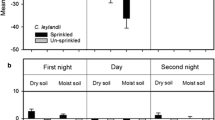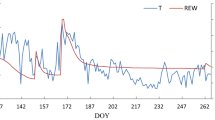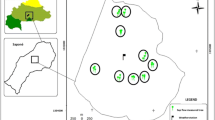Abstract
Seasonal drought may have a high impact on the karst ecosystem. The transpiration from Cyclobalanopsis glauca (syn. Quercus glauca) stand on a rocky hilly slope in South China was measured during the dry period of 2006 by using the Granier’s sap-flow method. During the experimental period, maximum sap flux density (J s) ranged from 20 to 40 g H2O m−2 s−1 according to diameter of breast height (DBH) of individual trees. On sunny days, daily transpiration varied between 3.4 and 1.8 mm day−1. Transpiration of C. glauca was closely correlated to the radiation, air temperature, and vapor pressure deficit (VPD). Soil moisture was a very important factor influencing transpiration. The very low soil water content might result in low stand transpiration even when VPD is high, but high soil water content might also result in low transpiration if it was low VPD. However, VPD rather than soil moisture, affected largely the stand transpiration under high soil water content. The amount of transpiration was much more than that of the total soil moisture loss during the continuous sunny days, indicating that the dry shallow soils were probably not the only source for root-uptake water. C. glauca grows deep roots through the rock fissures of epikarst, indicating that epikarst might be another main source for sustaining transpiration in response to dry demand in autumn. Therefore, a large amount of deep roots of karst species would be a very important hydraulic connecting from the epikarst to above ground by transpiration, which would promote the biogeochemical process in a karst system.








Similar content being viewed by others
References
Allen SJ, Grime VL (1995) Measurements of transpiration from Savannah shrubs using sap-flow gauges. Agric For Meteorol 75:23–41. doi:10.1016/0168-1923(94)02201-T
Aranda I, Gil L, Pardos JA (2005) Seasonal changes in apparent hydraulic conductance and their implications for water use of European beech (Fagus sylvatica L.) and sessile oak [Quercus petraea (Matt.) Liebl] in South Europe. Plant Ecol 179:155–167. doi:10.1007/s11258-004-7007-1
Baker JM, van Bavel CHM (1987) Measurement of mass flow of water in the stems of herbaceous plants. Plant Cell Environ 10:777–782
Chandler GD (2006) Reversibility of forest conversion impacts on water budgets in tropical karst terrain. For Ecol Manage 224:95–103. doi:10.1016/j.foreco.2005.12.010
David TS, Ferreira MI, Cohen S (2004) Constraints on transpiration from an evergreen oak tree in southern Portugal et al. Agric For Meteorol 122:193–205. doi:10.1016/j.agrformet.2003.09.014
Dolman AJ, Allen SJ, Lean J (1993) Climate simulations of the Sahel: a comparison with surface energy balance observations. IAHS Publ 212:513–519
Dragoni D, Lakso AN, Piccioni RM (2005) Transpiration of apple trees in a humid climate using heat-pulse sap-flow gauges calibrated with whole-canopy gas exchange chambers. Agric For Meteorol 130:85–94. doi:10.1016/j.agrformet.2005.02.003
Dünisch O, Morais RR (2002) Regulation of xylem sap flow in an evergreen, a semi-deciduous, and a deciduous Meliaceae species from the Amazon. Trees (Berl) 16:404–416
Granier A (1987) Evaluation of transpiration in a Douglas-fir stand by means of sap flow measurements. Tree Physiol 3:309–320
Guangxi Soil Fertilizer Working Group (1994) Guangxi Soil (in Chinese). Guangxi Science and Technology Press, Nanning, pp 148–162
Guo F, Jiang GH, Yuan DX (2007) Major ions in typical subterranean rivers and their anthropogenic impacts in southwest karst areas, China. Environ Geol 53(3):533–541. doi:10.1007/s00254-007-0665-2
Huntoon PW (1992) Hydrogeologic characteristics and deforestation of the stone forest karst aquifers of south China. Ground Water 30:167–176. doi:10.1111/j.1745-6584.1992.tb01788.x
Jiang ZC (1998) Features of epikarst zone in south China and formation mechanism (in Chinese). Chin Trop Geogr 18(4):322–326
Jiang ZC, Wang RJ, Pei JG, He SY (2001) Epikarst zone in south China and its regulation function to karst water (in Chinese). Carsologica Sin 20(2):106–110
Kitamura S, Murata G (1979) Colored illustrations of woody plants of Japan (in Japanese). Oikusha, Osaka, p 545
Köstner B, Granier A, Cermak J (1998) Sap flow measurements in forest stands: methods and uncertainties. Ann For Sci 55:13–27. doi:10.1051/forest:19980102
Liu F, Wang SJ, Luo HB (2006) Vegetation succession with karst rocky desertification and its impact on water chemistry of runoff. Acta Pedologica Sin 143(11):27–32
Lou Y, Zhou ZK (2001) Phytogeography of Quercus subg. Cyclobalanopsis (in Chinese). Acta Bot Yunnanica 23(1):1–16
Lu P, Urban L, Zhao P (2004) Granier’s thermal dissipation probe (TDP) method for measuring sap flow in trees: theory and practice. Acta Bot Sin 46(6):631–646
Massman WJ (1992) A surface energy balance method for partitioning evapotranspiration data into plant and soil components for a surface with partial canopy cover. Water Resour Res 28:1723–1732. doi:10.1029/92WR00217
Muthukumar T, Sha LQ, Yang XD (2003) Distribution of roots and arbuscular mycorrhizal associations in tropical forest types of Xishuangbanna, southwest China. Appl Soil Ecol 22:241–253. doi:10.1016/S0929-1393(02)00156-7
O’Brien JJ, Oberbauer SF, Clark DB (2004) Whole-tree xylem sap flow responses to multiple environmental variables in a wet tropical forest. Plant Cell Environ 27:551–567. doi:10.1111/j.1365-3040.2003.01160.x
Stewart S, Burgess O (2006) Measuring transpiration responses to summer precipitation in a Mediterranean climate: a simple screening tool for identifying plant water-use strategies. Physiol Plant 127:404–412. doi:10.1111/j.1399-3054.2006.00669.x
Trček B (2007) How can the epikarst zone influence the karst aquifer hydraulic behaviour? Environ Geol 51(5):761–765. doi:10.1007/s00254-006-0387-x
Wallace JS, Lloyd CR, Sivakumar MVK (1993) Measurements of soil, plant and total evaporation from millet in Niger. Agric For Meteorol 63:149–169. doi:10.1016/0168-1923(93)90058-P
Yanagisawa N, Fujita N (1999) Different distribution patterns of woody species on a slope in relation to vertical root distribution and dynamics of soil moisture profiles. Ecol Res 14:165–177. doi:10.1046/j.1440-1703.1999.00295.x
Yuan DX (1993) Environmental change and human impact on karst in south China. In: Williams P (eds) Karst terrains, environmental change and human impact. Catena Suppl 25:104
Zhang C, Yuan DX, Cao JH (2005) Analysis of the environmental sensitivities of a typical dynamic epikarst system at the Nongla monitoring site, Guangxi, China. Environ Geol 47(5):615–619. doi:10.1007/s00254-004-1186-x
Zhang ZG (1996) Drought and flood hazards in southern China bare karst and approaches to their control (in Chinese). Carsologica Sin 15(1):1–10
Zhao P, Rao XQ, Ma L, Cai XA, Zeng XP (2005) Application of Granier’s sap flow system in water use of Acacia mangium forest (in Chinese). Chin J Trop Subtrop Bot 13(6):457–468
Zhu XK, Zhu SQ (2000) Study on asexual reproduction ecology of Ltea ilicifolia in Karst Stone Mountain I-root morphology and biomass allocation (in Chinese). J Mt Chin Agric Biol 19(1):6–9
Acknowledgments
This work was supported by the Provincial Nature Science Foundation of Guangxi (Grant No. 0575009), the Personnel Training Program of West Light Foundation of Chinese Academy of Sciences (2005), Guangxi Science and Technology (Grant No. 0322021), National Nature Science Foundation of China (30428022, 30770328), Provincial Nature Science Foundation of Guangdong (7006917), and the Knowledge Innovation Program of the Chinese Academy of Sciences (KSCX2-SW-133). Thanks are also due to Lu ping, Cai Xian, Ma Ling, Lu Shuhua, and Wang Qing for their kind suggestions and help in installing the equipment in the field. Special thanks are also due to Mr. David Bromwich and Mr. Huang Guangbin for their help in polishing the language of the paper.
Author information
Authors and Affiliations
Corresponding author
About this article
Cite this article
Huang, Y., Zhao, P., Zhang, Z. et al. Transpiration of Cyclobalanopsis glauca (syn. Quercus glauca) stand measured by sap-flow method in a karst rocky terrain during dry season. Ecol Res 24, 791–801 (2009). https://doi.org/10.1007/s11284-008-0553-6
Received:
Accepted:
Published:
Issue Date:
DOI: https://doi.org/10.1007/s11284-008-0553-6




